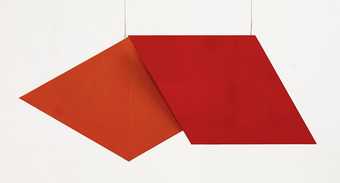
Hélio Oiticica
Spatial Relief (red) REL 036 (1959)
Tate
With the construction of the country’s new utopian capital, Brasilia and the formation of the São Paulo Biennial, young Brazilian artists were inspired to create art that drew on contemporary theories of cybernetics, gestalt psychology and the optical experiments of international artists like Bridget Riley and Victor Vasarely.
Lygia Clark, Lygia Pape, Am’lcar de Castro, Franz Weissmann, Reynaldo Jardim, Sergio de Camargo, Theon Spanudis and Ferreira Gullar were unhappy with the dogmatic approach of the concrete group, so published the neo-concrete manifesto in 1959. In 1960 Hélio Oiticica joined the group and his groundbreaking series of red and yellow painted hanging wood constructions effectively liberated colour into three-dimensional space.
